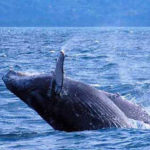23 interesting facts about narwhals
 One of the most amazing marine life is narwhals. They belong to animals, not to fish, and are related to whales. Fortunately, now there is no systematic hunt for them, so the narwhal population is not in danger, despite the active spread of human civilization in their habitats.
One of the most amazing marine life is narwhals. They belong to animals, not to fish, and are related to whales. Fortunately, now there is no systematic hunt for them, so the narwhal population is not in danger, despite the active spread of human civilization in their habitats.
In ancient times, it was believed that a piece of the horn of this animal is an indicator of poison. It was believed that it will change color if you throw it in a poisoned drink.
The colder the water, the less narwhals consume oxygen, so in winter they are less likely to rise to the surface behind a breath of air than in summer.
Narwhal cubs often fall prey to polar sharks. These predatory fish cannot overcome adult narwhals.
They prefer to live in groups, but small, usually no more than a dozen individuals. This distinguishes them from many other cetaceans, gathering in large herds of hundreds of animals.
Predatory killer whales and polar bears on occasion happily hunt narwhals.
The average life span of these animals reaches 50 years.
Narwhals from time to time rub their tusks against the tusks of relatives. Thus, they cleanse them of dirt and growths.
They can dive to a depth of up to a thousand meters.
The narwhal horn is very durable, but if it breaks, the new one will not grow back.
There have been cases when narwhals, being furious with something, drowned small fishing boats.
The length of the largest narwhal tusk available to the museum reaches 3 meters. At the same time, it weighs only ten kilograms.
In medieval Europe, the horns of narwhals often stood out as horns of unicorns.
Communicating with each other, narwhals emit a number of clicking and gurgling sounds. In fact, each of them has a certain meaning, and they understand each other perfectly.
Sometimes the ice covering the surface of the sea prevents the narwhals from swallowing fresh air. In this case, they usually try to break it with their backs or their tusks, and, as practice shows, they break ice with a thickness of 5-6 cm without problems.
Narwhals live only in cold salty water, but in winter they sometimes descend south. They were noticed off the coast of France and Great Britain.
Keeping narwhals in captivity is simply not possible. Deprived of their freedom, these creatures become depressed and soon die.
Studies have shown that when hunting, narwhals sometimes use their tusks like clubs, stunning their prey.
In their tusks are millions of nerve endings.
The fat layer of narwhals reaches 9-10 cm in thickness, and accounts for up to a third of the total weight of these animals. This is comparable to the thickness of the fat layer in seals and walruses.
Over the past few centuries, narwhals have become smaller on average. Even in the XVIII century, individuals were 6 meters long, but no one had seen such giants for a long time, and adult narwhals grow to 4-4.5 meters.
Male narwhals weigh up to 3 tons, and females usually weigh up to 1 ton.
These animals do not have a dorsal fin that is common to most marine life.
Narwhals have only two teeth, and one of them grows, turning into a tusk. About one narwhal from five hundred into a tusk develops both teeth.



























